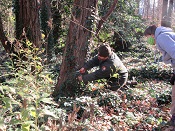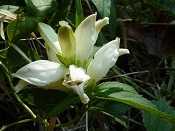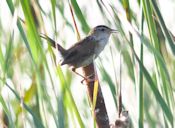
Barred Owls Boost Spirits

Spring’s rebirth is always uplifting, especially when Dyke Marsh’s avian heroes and heroines put on a show. In May 2021, many people delighted in observing a barred owl pair (Strix varia) and their three young near the Haul Road trail.
Josh Brick shared a video of the two adults appearing to display affection or preening. “It was hard to pull ourselves away,” Josh reported.
Bald Eagles and Ospreys Put on a Show

In early May 2021, the eaglet pair in one of the nests in Dyke Marsh is growing up. They are often visible to visitors. The flapping eaglet is exercising its wing muscles, in preparation for flight. Young bald eagles typically fledge in Northern Virginia in June.
In these stunning photographs by Ashley Bradford taken on May 2, one of the eaglets leapt up and flapped and got up above the edge of the nest before dropping back down into it.
Volunteers Are Saving Dyke Marsh’s Trees

In 2021 in five sessions, as of April 4, 2021, FODM volunteers have collected 136 bags of English ivy off trees, an effort to save the trees.
English ivy (Hedera helix L.) is an invasive, evergreen, aggressive invader that can outcompete and smother native plants, block sunlight needed by herbs and seedlings and spread into the forest canopy.
Flying Squirrels Wow the Crowd

On February 17, 2021, 89 people became instant fans of the native southern flying squirrel (Glaucomys volans) thanks to a much-applauded Zoom presentation by naturalist Kim Young, from Fairfax County Park Authority’s Hidden Oaks Nature Center.
Ms. Young detailed the identifying characteristics, behavior, diet and habitat of these members of the rodent family, animals that weigh about the same as a cellphone, 2 ½ ounces, and are eight inches long, with their tail being from a third to a half of that length.
Plants Shaped by Water

“Water is essential for all life,” explained Charles Smith, opening his talk on November 10, 2020, a presentation titled “Plants Shaped by Water.” No matter where plants are, they need water, from a little carnivorous sundew to wetland pickerelweed to giant oak trees. Some systems, like saltwater and freshwater wetlands, are defined by water. Smith is a branch chief with the Fairfax County Stormwater Planning Division, a certified ecological restoration practitioner and a Virginia master naturalist instructor.
Sora Heard in the Marsh

The sora (Porzana Carolina) is the most abundant and widely distributed species of marsh-loving birds called rails (family Rallidae) in North America. In the 1960s, they were frequently seen in migration at Dyke Marsh, according to surveys conducted by Jackson Abbott.
Today, they are rarely encountered, so it was a rare treat when people heard at least five in the marsh in the early morning hours of October 18, 2020. “The sora makes its presence known with plaintive whistles and whinnies,” wrote Kenn Kaufman in Lives of North American Birds. This rail is mottled brown and gray with white-edged feathers, around eight to ten inches in length, two to four ounces in weight, has a bright yellow “candy corn” bill and nervously flicks its tail.
Dyke Marsh Volunteers Survey Insects

Since 2016, volunteers from FODM and the Audubon Society of Northern Virginia have conducted surveys of butterflies, dragonflies and damselflies in Dyke Marsh from April to October. Here are the total numbers of species documented from 2016 through September 23, 2020: butterflies, 50 species; damselflies, 12 species; dragonflies, 37 species. While surveying, they also document other insects.
Pandemic Pollution: More Trash

Friends of Dyke Marsh volunteers typically collect 30 bags of trash along the Potomac River shoreline during two-hour cleanups. On September 26, 2020, 17 volunteers filled 42 bags.
One consequence of the coronavirus pandemic in 2020 has been a substantial increase the amount of trash on our streets, parking lots and land, much of which ultimately ends up in our waterways. Observers often find wipes, masks and rubber gloves littered across the landscape. With more people ordering takeout food, there appears to be an increase in food packaging materials as well.
Wetland Systems and their Value: Subject of FODM Meeting

At FODM’s quarterly meeting on September 8, 2020, George Mason University professor Dr. Christian Jones gave a Zoom presentation on wetlands systems of the mid-Atlantic region, their value and threats. Dr. Jones, a freshwater ecologist with GMU’s Potomac Environmental Research and Education Center, explained that wetlands have several valuable functions, including storing water, recharging groundwater, mitigating flooding and buffering shorelines from storms. Wetlands, like peat bogs, store carbon emitted into the air and thus help mitigate climate change.
New Dragonfly Species for Dyke Marsh Documented

On August 19, 2020, Ed Eder identified a dragonfly species in Dyke Marsh, the Swift River cruiser (Macromia illinoiensis illinoiensis), never before documented in the preserve.
These dragonflies are about three inches long and have bright green eyes and a single yellow thoracic side stripe. They have yellow spots along the length of their abdomens. Males have a slightly clubbed tail.
Marsh Wrens, a Glimmer of Hope?

In early August 2020, FODMers observed two or three male marsh wrens (Cistothorus palustris) in Dyke Marsh in what FODMers call “the Big Gut.” It appeared that none of the birds had a mate and since it was so late in the breeding season, the observers believe that it will be unlikely for these birds to attract a mate this year so late in the season.
These volunteers heard the unmistakable bubbly call of the marsh wren and saw several dummy nests but no complete nest. This male likely represents the remnant population of what was once a thriving marsh wren colony and is a reminder of the fragility of the habitat and the loss of significant marsh acreage in the preserve. See “Restoration.”
Dyke Marsh Is Lush in the Summer

Dyke Marsh is like a “sea of green” in the summer when wetland plants like wild rice (Zizania aquatica) are at their height. Wild rice shimmers in the breeze and can grow to be 10 feet tall. In the second photo, it is in flower or bud. In the third, it is in fruit.


AlbertHerring-b4cc6b5cfb.jpg)



 Friends of Dyke Marsh, Inc. is a non-profit 501(c)(3) organization.
Friends of Dyke Marsh, Inc. is a non-profit 501(c)(3) organization.